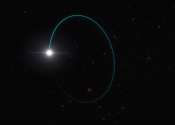Astronomers image magnetic fields at the edge of M87's black hole
The Event Horizon Telescope (EHT) collaboration, which produced the first-ever image of a black hole, has today revealed a new view of the massive object at the center of the Messier 87 (M87) galaxy: How it looks in polarized ...









